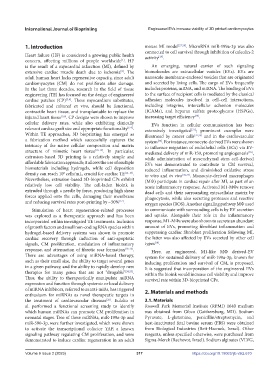Page 325 - IJB-9-2
P. 325
International Journal of Bioprinting Engineered EVs increase viability of 3D printed cardiomyocytes
1. Introduction mouse MI model [27,28] . MicroRNA miR-199a-3p was also
connected to cell survival through inhibition of caleolin-2
Heart failure (HF) is considered a growing public health activity .
[29]
concern, affecting millions of people worldwide . HF
[1]
is the result of a myocardial infarction (MI), defined by An emerging, natural carrier of such signaling
[2]
extensive cardiac muscle death due to ischemia . The biomolecules are extracellular vesicles (EVs). EVs are
adult human heart lacks regenerative capacity, since adult nanoscale membrane-enclosed vesicles that are originated
cardiomyocytes (CM) do not proliferate after damage. and secreted by living cells. The cargo of EVs frequently
In the last three decades, research in the field of tissue includes proteins, mRNA, and miRNA. The binding of EVs
engineering (TE) has focused on the design of engineered to the surface of recipient cells is mediated by the classical
cardiac patches (CP) [3,4] . These myocardium substitutes, adhesion molecules involved in cell–cell interactions,
fabricated and cultured ex vivo, should be functional, including integrins, intercellular adhesion molecules
contractile heart tissue, and transplantable to replace the (ICAMs), and heparan sulfate proteoglycans (HSPGs),
[30]
injured heart tissue [5,6] . CP designs were shown to improve increasing target efficiency .
cellular delivery rates, while also exhibiting clinically EVs function in cellular communication has been
relevant cardiac graft size and appropriate functionality [6-9] . extensively investigated ; prominent examples were
[31]
Within TE approaches, 3D bioprinting has emerged as illustrated by cancer cells [32,33] and in the cardiovascular
a fabrication method which successfully captures the system . For instance, monocyte-derived EVs were shown
[34]
intricacy of the native cellular composition and matrix to influence migration of endothelial cells (ECs) via EV-
structure of mimetic heart tissue [10-13] . In particular, mediated delivery of miR-150, promoting angiogenesis ,
[35]
extrusion-based 3D printing is a relatively simple and while administration of mesenchymal stem cell-derived
affordable fabrication approach; it allows the use of multiple EVs was demonstrated to contribute to CM survival,
biomaterials including hydrogels, while cell deposition reduced inflammation, and diminished oxidative stress
density can reach 10 cells/mL, crucial for cardiac TE [14-16] . in vitro and in vivo [36,37] . Monocyte-derived macrophages
8
Nevertheless, extrusion-based 3D-bioprinted CPs exhibit (MΦ) participate in cardiac repair after MI, as part of an
relatively low cell viability. The cell-laden bioink is acute inflammatory response. Activated M1-MΦs remove
extruded through a needle by force, producing high shear dead cells and their surrounding extracellular matrix by
forces applied onto the cells, damaging their membrane phagocytosis, while also secreting proteases and reactive
[17]
and reducing survival rates post-printing by ~50% . oxygen species (ROS). Another signaling pathway MΦ used
Stimulation of heart regeneration-related processes to communicate with surrounding cells is by EV secretion
was explored as a therapeutic approach and has been and uptake. Alongside their role in the inflammatory
incorporated within investigated TE treatments. Inclusion response, M1-MΦs were also shown to secrete an abundant
of growth factors and small non-coding RNA species within amount of EVs, promoting fibroblast inflammation and
hydrogel-based delivery systems was shown to promote suppressing cardiac fibroblast proliferation following MI,
cardiac recovery through induction of anti-apoptotic the latter was also affected by EVs secreted by other cell
[38]
signals, CM proliferation, modulation of inflammatory types .
response, and attenuation of fibrotic scar formation [18-23] . Here, an engineered, M1-like MΦ derived-EV
There are advantages of using miRNA-based therapy, system for sustained delivery of miR-199a-3p, known for
such as their small size, the ability to target several genes inducing proliferation and survival of CM, is proposed.
in a given pathway, and the ability to rapidly develop new It is suggested that incorporation of the engineered EVs
therapies for many genes that are not “drugable” [24,25] . within the bioink would increase cell viability and improve
Thus, the ability to therapeutically manipulate miRNA survival rate within 3D-bioprinted CPs.
expression and function through systemic or local delivery
of miRNA inhibitors, referred to as anti-miRs, has triggered 2. Materials and methods
enthusiasm for miRNAs as novel therapeutic targets in
the treatment of cardiovascular diseases . Eulalio et 2.1. Materials
[26]
al. performed a functional screening study to identify Roswell Park Memorial Institute (RPMI) 1640 medium
which human miRNAs can promote CM proliferation in was obtained from Gibco (Gaithersburg, MD). Sodium
neonatal stages. Two of these miRNAs, miR-199a-3p and Pyruvate, L-glutamine, penicillin/streptomycin, and
miR-590-3p, were further investigated, which were shown heat-inactivated fetal bovine serum (FBS) were obtained
to activate the transcriptional cofactor YAP, a known from Biological Industries (Beit-Haemek, Israel). Other
signaling pathway regulating CM proliferation, and were reagents, unless specified otherwise, were purchased from
demonstrated to induce cardiac regeneration in an adult Sigma-Merck (Rechovot, Israel). Sodium alginates (VLVG,
Volume 9 Issue 2 (2023) 317 https://doi.org/10.18063/ijb.v9i2.670

